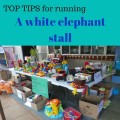
When you are running a white elephant stall, second-hand stall, garage sale, boot sale or pre-loved stall, whether it be books, clothes, household junk or toys, getting the pricing right is key.
Price too low and you lose out on potential income, price too high and you are left with boxes of unwanted second-hand stuff. But how do you find the right balance so that you maximise your income and your sales?
Tip 1. A general rule for pricing second-hand items is between 10% and 30% of the original price, depending on its condition, rarity and perceived value.
Tip 2: Know what you have. Keep aside anything that looks brand new, unwrapped, excellent condition or possibly valuable. You may consider using these things as raffle or auction prizes which will probably make more money than selling it on the second-hand stall.
Tip 3. Separate the valuable items and put a premium on them. Certain items, like large play-sets, Lego and baby equipment which are very pricey when new, can be big sellers at white elephant stalls, and you can increase the price up to 50% of the original price for things in really good condition.
Tip 4. Take the time to price everything. Price ambiguity is a major turn-off with customers, especially if it seems the sellers are making it up as they go along. Invest in some packets of white dot stickers and write the price on them using a Sharpie. Using different colour stickers to represent different price points is fine when you have lots of similar items, but keep in mind people will often ignore or not notice the sign explaining what the colours mean and will end up asking you ‘how much is this?’ anyway. Having everything individually priced also reduces the pressure to haggle.
Tip 5. Know your audience. If you are running a white elephant stall where the majority of customers will be students and families who donated the items in the first place, it is best to keep the prices very low. Parents don’t always get as excited about a four-foot high stuffed Elmo as their kid might. Where a parent might reasonably say ‘no’ to a $10 Elmo, they will be more likely to shrug and say ‘ok’ to a $4 Elmo (especially if they know they can donate it to next year’s stall).
Tip 6: Have a plan to dispose of unsold items. If you have a clear plan of where to dispose of unsold items (such as a nearby charity or op-shop) you will be less stressed about selling everything and be able to keep prices slightly higher.
Tip 7. Don’t be afraid to have a ‘Freebie’ box. This ultimately won’t affect your income and people who grab a couple of free toys are more likely to spend a few dollars buying something else. Alternatively, you can offer shoppers the choice of a free toy once they purchase something.
Tip 8. People often approach second-hand stalls thinking of a certain amount they are willing to spend – it may be $10 or it may be $30. If you have lots of items which are $10 or more, sometimes it might be a good idea to advertise these in advance, especially if they are particularly unusual or valuable. They may even act as a drawcard.
Tip 9. Keep price points as simple as possible – 50 cents, $1, $2 and $5. If you have lots of similar items, such as kids picture books or old Barbie dolls, put them in a box with a sign saying ‘All children’s books 50 cents each.’
Tip 10. Clothes and toys are good to bundle. Shoppers feel like they are getting a good bargain, you are less likely to have leftovers at the end of the day, and you save a lot of time not having people pick through large boxes of clothes. Make sure you bundle according to size and gender – such as a bag of baby romper suits, bags of boys t-shirts, bags of girls play dresses etc and ensure you have at least one really excellent piece in each bag, preferably well displayed at the top.
Tip 11. Don’t try and price things you are personally attached to. If you are selling your Grandad’s old collection of fishing magazines and think they are hugely valuable, either don’t sell them, or get someone else to price them. Asking someone ‘what would you pay for this?’ is a great way to get a reasonable price point.
Tip 12. If your goal is to have nothing left at the end of the sale, then you may need to drop the price or offer sales as the day progresses. Two hours before you close, offer a bag of kids’ clothes or a box of books for $10. Place smaller items and toys into the ‘Freebie’ box. One hour before you are due to close – offer bags/boxes which people can fill for $2 or $5. You can always promote the sales early in the day, so that people return to grab a bargain. It won’t stop people paying full price early in the day, as they know there would be no guarantee the item would still be there later on.
Tip 13. Take the time to clean toys, rub scuff marks off shoes, place adult clothing on hangers and store books with their spines all facing the same way. A good looking stall will undoubtedly make more money than one where everything is tipped onto a blue tarp on the ground. Click here for tips on how to set up your white elephant stall to maximise your profit.
Related articles: no



